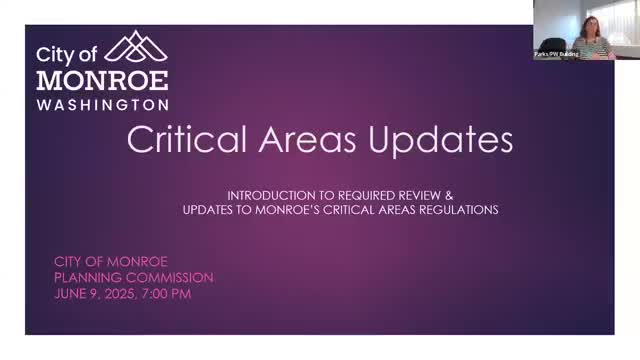Commission begins multi‑month update of critical‑areas regulations; focus on best available science and avoidance
June 12, 2025 | Monroe City, Snohomish County, Washington
This article was created by AI summarizing key points discussed. AI makes mistakes, so for full details and context, please refer to the video of the full meeting. Please report any errors so we can fix them. Report an error »

Planning staff introduced the start of a multi‑month update to Monroe’s critical‑areas regulations on June 9, telling the Planning Commission the work is required as part of the city’s periodic comprehensive‑plan review and must be adopted by the end of the year (with limited extra time if progress is demonstrated).
Planner Kate said the update will emphasize best available science, add or revise definitions, consolidate citations to external mapping resources (Department of Ecology, Department of Fish and Wildlife, Snohomish County), and strengthen the code’s emphasis on avoidance and function when projects intersect wetlands, streams, steep slopes, frequently flooded areas, geologically hazardous areas and fish and wildlife habitat conservation areas.
Staff noted the following items in the draft materials and discussion:
- Definitions and mapping: staff has organized existing critical‑areas definitions in Title 22 and will add references to external best‑available‑science sources and local maps for wetlands, streams, steep slopes and other resources.
- Critical aquifer recharge areas: staff reported Snohomish County mapping currently indicates no critical aquifer recharge areas inside Monroe city limits, but said it will follow up to confirm that status and account for any private wells or special districts.
- Buffers and density transfer: staff said buffer requirements show no large changes in the initial review but highlighted that density transfer rules (allowing density to move from constrained to unconstrained areas) will receive focused review.
- Schedule: Kate said the work will come back to the commission in chunks, with formal review planned for September–October and final City Council adoption aimed before year end.
Why it matters: updates to critical‑areas rules affect where and how development can occur, how mitigation is prioritized (avoidance first), and how property owners and applicants plan around environmental constraints.
Next steps: staff will consult subject‑matter experts (Department of Fish and Wildlife has already reached out) and bring proposed code amendments in stages this summer and fall.
Planner Kate said the update will emphasize best available science, add or revise definitions, consolidate citations to external mapping resources (Department of Ecology, Department of Fish and Wildlife, Snohomish County), and strengthen the code’s emphasis on avoidance and function when projects intersect wetlands, streams, steep slopes, frequently flooded areas, geologically hazardous areas and fish and wildlife habitat conservation areas.
Staff noted the following items in the draft materials and discussion:
- Definitions and mapping: staff has organized existing critical‑areas definitions in Title 22 and will add references to external best‑available‑science sources and local maps for wetlands, streams, steep slopes and other resources.
- Critical aquifer recharge areas: staff reported Snohomish County mapping currently indicates no critical aquifer recharge areas inside Monroe city limits, but said it will follow up to confirm that status and account for any private wells or special districts.
- Buffers and density transfer: staff said buffer requirements show no large changes in the initial review but highlighted that density transfer rules (allowing density to move from constrained to unconstrained areas) will receive focused review.
- Schedule: Kate said the work will come back to the commission in chunks, with formal review planned for September–October and final City Council adoption aimed before year end.
Why it matters: updates to critical‑areas rules affect where and how development can occur, how mitigation is prioritized (avoidance first), and how property owners and applicants plan around environmental constraints.
Next steps: staff will consult subject‑matter experts (Department of Fish and Wildlife has already reached out) and bring proposed code amendments in stages this summer and fall.
View full meeting
This article is based on a recent meeting—watch the full video and explore the complete transcript for deeper insights into the discussion.
View full meeting
